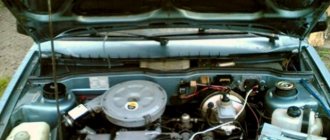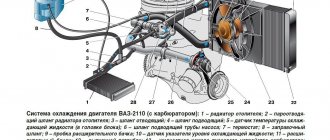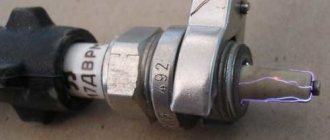The gearbox contains numerous moving parts that, when rubbing against each other, can generate large amounts of thermal energy. To cool the moving mechanisms of an automatic transmission, a special transmission oil is used, which simultaneously cools and lubricates the moving elements. Problems with the lubrication system invariably lead to an increase in the operating temperature of the automatic transmission. In this case, the coolant temperature can reach 120 degrees or more, at which the lubricant loses its properties and increased wear of the gearbox begins.
Off-season rules (don't forget)
- Do not skid or tow.
These modes overload and overheat the units even in cool weather, and simply kill them in hot weather.
Particularly dangerous for an automatic transmission or CVT is slipping in mud and towing a heavy trailer in the heat.
Particularly dangerous for an automatic transmission or CVT is slipping in mud and towing a heavy trailer in the heat.
- Monitor the level of working fluid in the box.
In the heat, leaks through the slightest leaks intensify. Overload from the heat combined with an incorrect fluid level will quickly lead to the death of the unit.
Regularly check the level in the box using a dipstick. Important: measurements must be taken at the temperature specified in the instructions for the car.
If there is no dipstick, inspect the box body and the place where you park the car more often.
If your car has a dipstick to control the fluid level, consider yourself lucky.
If your car has a dipstick to control the fluid level, consider yourself lucky.
Consequences of automatic transmission overheating
Overheating of the automatic transmission leads to failure of solenoids, clutches and other moving elements. In some cases, even 10 - 20 minutes of operation of the gearbox in overheating mode is enough, which leads to serious damage and the need for major repairs. That is why, at the first signs of overheating, as a rule, this is indicated by sensors built into the gearbox, it is necessary to turn off the car and transport it to a service station on a tow truck. This way you can avoid significant problems caused by prolonged operation of the gearbox at elevated temperatures. During long-term operation of the gearbox with an increased operating temperature, problems may arise with the geometry of the hydraulic plate and control unit. It should be remembered that a control unit that has failed due to overheating cannot be repaired and therefore requires an expensive replacement. It is for this reason that the car owner needs to closely monitor the condition of the gearbox and, when the first reports of oil overheating in the automatic transmission appear, contact a specialized service center.
This also happens - with severe overheating, the torque converter turns blue and the ventilation tubes melt
Is it worth installing an additional radiator?
Long intervals between oil changes, savings on technical fluid and other consumables, aggressive use of the vehicle - all these factors greatly reduce the service life of the transmission. It is worth remembering that the CVT is designed for quiet driving and does not tolerate prolonged driving at high speed. High vehicle load also negatively affects the reliability of the CVT. While the car is under warranty, it is not necessary to install an additional radiator, but after the end of this period, the issue of ensuring proper cooling must be seriously addressed.
Some motorists do all the work themselves, but it is best to entrust the car to professionals. Mitsubishi often installs a radiator from a UAZ Patriot; you will need a cooler housing with four terminals, hoses, clamps and brackets. The specifics of installing an external radiator on different cars differ significantly. On Mitsubishi Lancer 10, Outlander 3 and ASX it is one, but on cars produced by Nissan it is already different. By spending 30-40 thousand rubles, you can eliminate the risk of overheating of the variator and create optimal conditions for long-term operation of the transmission. Do not skimp on the radiator and materials, since the subsequent stable operation of the entire cooling system depends on their quality.
Message about variator overheating
A dirty variator radiator is the cause of overheating
edit this post
How to avoid overheating of oil in automatic transmission
Increase the cooling circuit. An automatic transmission cooler will also help keep your transmission from overheating and extend its life. In cars where the automatic transmission cooler is integrated with the main radiator, an additional section is included in the general cooling circuit and installed outside the radiator.
The choice of heat exchanger size must be justified. Too large will be expensive to maintain, and too small will not help regulate operating temperature.
Radiator manufacturers recommend adhering to the following calculations:
- for vehicles with engine capacity up to 2.0 l, 4-row design;
- cars with a trailer and an engine up to 3.0 l - 6-row;
- more powerful cars are 8-row.
The cooling circuit is designed for a certain heat output, and installing an additional radiator will upset the balance of heat output, meaning the automatic transmission will take longer to warm up in winter. To solve this problem, thermostats are installed along the path of the additional heat exchanger. The system will be able to automatically connect the radiator when the threshold of dangerous operating temperature of the gearbox oil is reached.
If the transmission cooler is installed on top of the main radiator, check the condition of the existing radiator before installing the additional structure. May only require cleaning or replacement.
Symptoms of overheating
At the very beginning, I advise an automatic transmission or a CVT ELM327 (I wrote about it in detail, follow the link). You can install the TORQUE program on your phone, install ELM327 in the OBD2 connector and read the readings of many parameters, including the temperature of the automatic transmission. Next, find out your extreme heating characteristics (sometimes in repair manuals) and look at the readings through “ELMKU”. If everything is fine, then OK. If it is exceeded, we look for reasons
Symptoms may be:
- Shocks when switching
- Burnt oil smell
- Gear shifts poorly
- Shifting occurs at high speeds
- The overheat indicator constantly lights up, especially after several sudden starts
- In the most severe cases, gears may not engage at all.
As you can see, nothing fun.
Now there's an interesting video, let's watch it
I will end here, I think my materials are useful to you. Subscribe to the YOUTUBE channel and read my website. YOURSINCERELY AUTOBLOGGER
Similar news
- CVT (variable gearbox): what is it, the principle of…
- Double clutch. What is it, the basic principle of operation. Plus …
- Automatic transmission clutches. What are they, how do they work and why do they burn?
Normal automatic transmission temperature
The degree of heating of a “classic” gearbox is related to the quality of the ATF working fluid - automatic transmission oil.
It performs more functions than motor oil:
- He lubricates the assembly.
- Cools friction areas.
- Protects the structure from corrosion.
- It creates operating pressure that compresses the friction clutches that change gears.
- Transmits torque from the engine to the wheels through a torque converter, i.e. acts like a clutch in an automatic transmission.
Under heavy engine loads, ATF heats up to 150 ℃ and wears out quickly. To prevent overheating, the automatic transmission oil passes through a cooling system, which reduces its operating temperature to a normal level of 75-95 ℃.
A short-term jump in operating temperature to 100-120℃ is not critical, but a constant increase in the rate every 20℃ reduces the oil service life by half and brings the transmission closer to a major overhaul.
Transmission oil operating temperature can be monitored on the vehicle's dashboard or using Torque Pro software and the ELM327 adapter. The scanner is connected to the diagnostic connector of the on-board computer, and data is downloaded via Bluetooth, Wi-Fi or USB, depending on the model.
Read Reasons for automatic transmission in alarm and troubleshooting modes
Automatic transmission overheating: consequences and signs
So, let us immediately note that a significant increase in the temperature of the transmission oil in an automatic transmission usually manifests itself in the form of certain malfunctions in the operation of the automatic transmission.
Ignoring such symptoms can lead to a reduction in the life of the unit itself or breakdowns. In other words, in this case, the automatic transmission often fails, after which an expensive overhaul or replacement of the transmission with a contract one is required.
Another feature of many hydromechanical automatic transmissions is the high heating of the gearbox oil in the torque converter. This device is actually an automatic transmission clutch, while the torque from the internal combustion engine is transmitted through the transmission fluid.
It becomes clear that problems in the automatic transmission or gas turbine engine, deviation from the norm in the oil level in the automatic transmission, a decrease in ATF pressure, as well as loss of properties of the transmission fluid itself lead to an increase in the temperature of the automatic transmission. In some cases, the oil in the automatic transmission heats up to 120 degrees or more.
Such heating is critical, the oil loses its properties, the unit malfunctions, and gearbox wear increases significantly. The consequences of automatic transmission overheating manifest themselves in the form of breakdown of solenoids, friction discs, as well as a number of other gearbox elements.
In practice, after a couple of tens of minutes, operating the automatic transmission in maximum heating mode will be enough for the unit to fail. For this reason, it is important to promptly identify symptoms of automatic transmission overheating. In cases where the automatic transmission overheats, signs of excessive heating can be determined independently. If the automatic transmission is severely overheated, the transmission ECU can switch the unit to the automatic transmission emergency mode.
The check or A/T light on the dashboard indicates problems with the automatic transmission. Various automatic transmission sensors record an increase in temperature, a decrease in ATF pressure, etc. In such a situation, it is not uncommon for the torque converter to literally turn blue from strong heat, the automatic transmission wiring melts, and the clutches burn and crumble.
In this case, when the automatic transmission goes into emergency mode, it is optimal to immediately stop using the car and take it to the service center under your own power, so as not to further worsen the situation. Moreover, if you plan to tow without hanging the drive wheels, then you need to separately take into account all the rules and nuances of such towing a car with an automatic transmission.
You need to understand that problems cannot be avoided in the future, since constant overheating, even if not critical, significantly reduces the life of clutches and solenoids, and can cause deformation of the valve body, etc. Under conditions of increased heating, the transmission oil itself also quickly loses its properties and becomes heavily contaminated. This means that the owner must constantly check the level and quality of the oil in the automatic transmission.
It is also important to note any changes in the operation of the unit and immediately carry out diagnostics, promptly change the automatic transmission oil and filter in the automatic transmission, and use high-quality fluids recommended by the transmission manufacturer itself.











